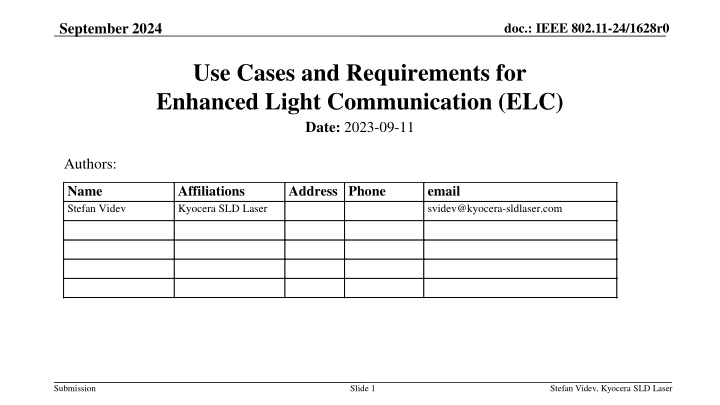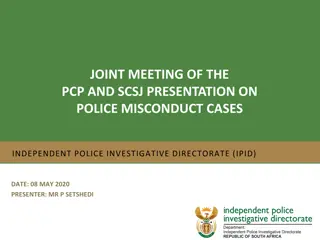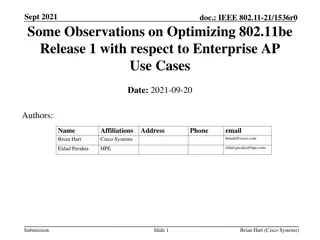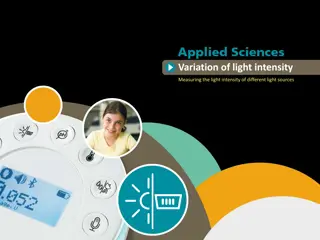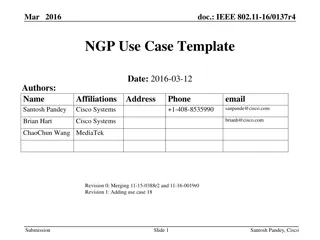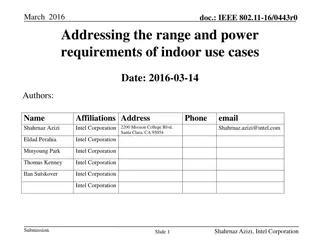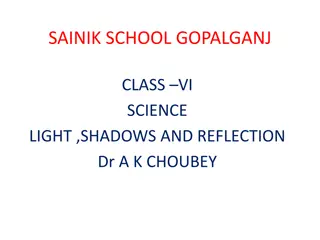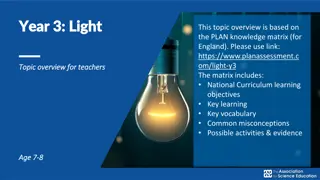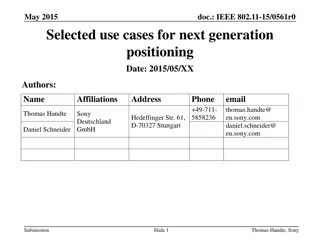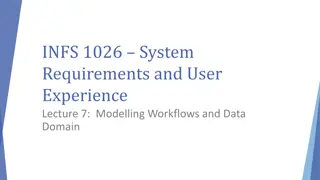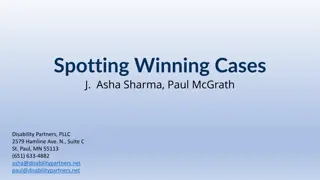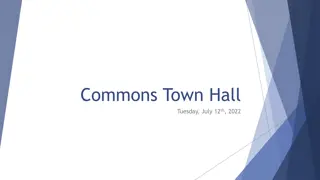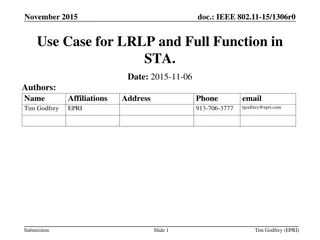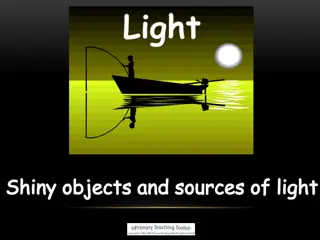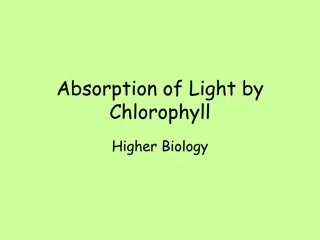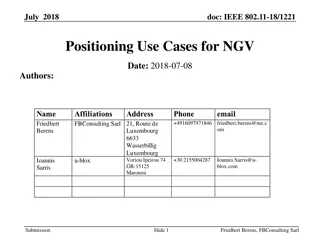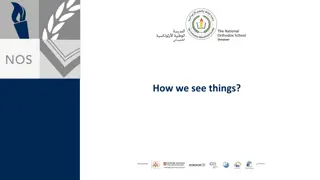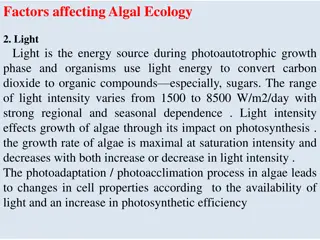Use Cases and Requirements for Enhanced Light Communication
This contribution discusses the unique use case enabled by Enhanced Light Communication (ELC), focusing on high-speed reliable wireless communication underwater, exploiting the advantages of light propagation and proposing features for the ELC project.
Download Presentation

Please find below an Image/Link to download the presentation.
The content on the website is provided AS IS for your information and personal use only. It may not be sold, licensed, or shared on other websites without obtaining consent from the author.If you encounter any issues during the download, it is possible that the publisher has removed the file from their server.
You are allowed to download the files provided on this website for personal or commercial use, subject to the condition that they are used lawfully. All files are the property of their respective owners.
The content on the website is provided AS IS for your information and personal use only. It may not be sold, licensed, or shared on other websites without obtaining consent from the author.
E N D
Presentation Transcript
September 2024 doc.: IEEE 802.11-24/1628r0 Use Cases and Requirements for Enhanced Light Communication (ELC) Date: 2023-09-11 Authors: Name Stefan Videv Affiliations Kyocera SLD Laser Address Phone email svidev@kyocera-sldlaser.com Submission Slide 1 Stefan Videv, Kyocera SLD Laser
September 2024 doc.: IEEE 802.11-24/1628r0 Abstract This contribution considers a use case that can be uniquely enabled by enhanced light communication (ELC). The idea is to exploit the favourable qualities of light propagation under water namely the wide bandwidth and relatively small attenuation. The current push for further understanding and exploration of our oceans and seas coupled with the recent advent of autonomous underwater vehicles have laid bare the need for a high-speed reliable means of wireless communication underwater. ELC can provide a vastly superior data rate compared to incumbent technologies, as well as provide positioning services in currently challenging environments. Moreover, ELC can provide a fully featured standardized modern networking solution which is currently missing. The contribution proposes some features to be considered in the scope of the ELC project. Submission Slide 2 Stefan Videv, Kyocera SLD Laser
September 2024 doc.: IEEE 802.11-24/1628r0 Outline Underwater Wireless Communication Technologies Overview Underwater Wireless Communication ELC Use Case Proposed Addition of Spectrum Motivation Issues of Backwards Compatibility Submission Slide 3 Stefan Videv, Kyocera SLD Laser
September 2024 doc.: IEEE 802.11-24/1628r0 Underwater Wireless Communication Technologies Overview Acoustic Communications Long range Low data rate (low kbps range) Susceptible to environmental interference Cannot go through air-water boundary Magnetic Field Communications Short range Low data rate (lower than acoustic) Less susceptible to noise Can go through air-water boundary Underwater Wireless Communications Standardization body exists, but unified standard does not No true modern fully featured standardized networking solutions exist Inter-product operation not guaranteed Submission Slide 4 Stefan Videv, Kyocera SLD Laser
September 2024 doc.: IEEE 802.11-24/1628r0 Underwater Wireless Communication ELC Use Case With deployment of sensors underwater (either standalone or on AUVs there is a growing requirement to exfiltrate data from underwater into the terrestrial data networks. Wireless connectivity is one of the best options as it potentially has a lower operational cost (vs physical retrieval) and the lowest risk of damaging equipment during data retrieval. Potentially large amounts of data are generated by sensors (imaging or other) and exfiltrating said data requires a high-speed means of doing so. [3] [2] [1] Submission Slide 5 Stefan Videv, Kyocera SLD Laser
September 2024 doc.: IEEE 802.11-24/1628r0 Underwater Wireless Communication ELC Use Case Further to data connectivity, the ELC system can provide ranging and positioning services which can prove invaluable in complex environments. The modern standardized networking capability would also enable complex deployments that will reduce complexity of deployment versus current solutions. Furthermore, the ELC systems could provide ranging and positioning services which can be invaluable in complex environments. Submission Slide 6 Stefan Videv, Kyocera SLD Laser
September 2024 doc.: IEEE 802.11-24/1628r0 Summary: Proposed features in scope of ELC The scope for Enhanced Light Communication (ELC) should include the following additions: i) Additional spectrum in the 450 nm region ii) Functionality on the PHY & MAC layers that would allow for ranging and positioning [4] services to be delivered Submission Slide 7 Stefan Videv, Kyocera SLD Laser
September 2024 doc.: IEEE 802.11-24/1628r0 References [1] Paul Esparon, Sunil Shah, Dr Timothy Nickels and the 2008 CAUV team., CC BY-SA 3.0 <https://creativecommons.org/licenses/by-sa/3.0>, via Wikimedia Commons [2] CSIRO, CC BY 3.0 <https://creativecommons.org/licenses/by/3.0>, via Wikimedia Commons [3] Picture taken by unknown photographer. Photo taken for MBARI Research Institute., CC BY-SA 4.0 <https://creativecommons.org/licenses/by-sa/4.0>, via Wikimedia Commons [4] Own work - Data from 380-728 nm: Pope R. M., Fry E. S. 1997. Absorption spectrum (380-700 nm) of pure water. II. Integrating cavity measurements. Appl. Opt. 36, 8710-8723 728-800 nm: Kou L., Labrie D., Ch lek P. 1993. Refractive indices of water and ice the 0.65- to 2.5- m spectral range. Appl. Opt. 32, 3531-3540 Combined data: Jonasz M. 2007. Absorption coefficient of water: Data sources (Data of Pope RM and Fry 1997 and of Kou L et al 1993). In: Top. Part. Disp. Sci. ( ISBN 0-9780628-0-9, Archive) Colour gradient: File:Spectrum4websiteEval.svg by Deborah S Krolls and Sakurambo Absorption coefficient of pure water from 380 nm to 800 nm at 22 C. Submission Slide 8 Stefan Videv, Kyocera SLD Laser
